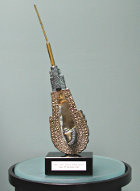In this video, Dr. Bernstein and a patient at Bernstein Medical are interviewed by Charles Gibson of Good Morning America in their two-part series on treating hair loss called, “The Bald Facts.” Dr. Bernstein discusses the importance of aesthetic planning of a hair transplant and the difference between the old “pluggy” transplants and today’s modern follicular unit transplantation techniques.
“Good Morning America” interviewed Dr. Bernstein in their two-part series on hair transplant surgery. Below is an excerpt from the interview:
 Charles Gibson: Are there good candidates and bad candidates for this?
Charles Gibson: Are there good candidates and bad candidates for this?
Dr. Bernstein: Yes. And actually people that wear hairpieces are sometimes tricky because their baseline is a full head of hair, so one of the important things that we had to discuss in the first consult was what his expectations were and whether he realized that a transplant wouldn’t give him the fullness of a hairpiece, but of course, it would look much more natural.
The Discovery Channel interviews Dr. Bernstein for a segment on hair transplant repair. View the segment, which includes footage of Dr. Bernstein speaking about hair transplantation and performing a transplant procedure
The Discovery Channel interviewed Dr. Bernstein for a piece on hair transplant repair. Below is an excerpt from the interview:
 Dr. Bernstein: When I first saw Ken in 1995. He still had the traditional plugs, and I would say on a scale of one to ten, he was maybe a seven, with ten being the worst. We performed a procedure called follicular unit transplantation where hair is transplanted in exactly the way it grows in nature, which are little tiny groups of one to four hairs.
Dr. Bernstein: When I first saw Ken in 1995. He still had the traditional plugs, and I would say on a scale of one to ten, he was maybe a seven, with ten being the worst. We performed a procedure called follicular unit transplantation where hair is transplanted in exactly the way it grows in nature, which are little tiny groups of one to four hairs.
Ken Gold: After the first surgery I was just ecstatic because I was actually able to look at myself in the mirror.
 In giving Dr. Bernstein the 2001 Platinum Follicle Award, the President of the ISHRS said:
In giving Dr. Bernstein the 2001 Platinum Follicle Award, the President of the ISHRS said:
“I proudly present the 2001 Platinum Follicle Award to Robert M. Bernstein, MD. Dr. Bernstein has contributed to the field of hair transplantation in dramatic and substantial ways, revolutionizing the advancement of Follicular Unit Hair Transplantation. His published articles have become ‘Bibles’ for this methodology.”
 Dr. Bernstein received the 2001 HairSite.com award for excellence in hair transplantation. “Dr. Bernstein is one of the most sought after hair transplant surgeons in the United States. He is one of the very few in the industry who is still involved in scientific and clinically related hair restoration research while engaging in hair transplant practice.”
Dr. Bernstein received the 2001 HairSite.com award for excellence in hair transplantation. “Dr. Bernstein is one of the most sought after hair transplant surgeons in the United States. He is one of the very few in the industry who is still involved in scientific and clinically related hair restoration research while engaging in hair transplant practice.”
Synopsis: This study compares the hair replacement techniques of mini-micrografting, vertical sectioning and single-strip harvesting with stereo-microscopic dissection for the generation of follicular unit grafts. It validated the superiority of the latter technique and supported the idea that if one wants to perform Follicular Unit Transplantation properly, single strip harvesting and microscopic dissection should be required.
Synopsis: This popular guide on hair restoration is revised to include the latest advances in medical and surgical treatments for hair loss and an expanded section of before and after photos.
Robert M. Bernstein, MD, William R. Rassman, MD, and Nazia Rashid Dermatologic Surgery 2001; 27(1): 5-11. College of Physicians and Surgeons, Columbia University, New York, New York Background The most common type of donor closure in hair transplantation is with non-absorbable, running sutures, usually of nylon or polypropylene. This is accomplished with, or without, buried […]
Synopsis: This paper introduces a new synthetic suture for surgical hair restoration called Poliglecaprone 25 or Monocryl. It is a strong, absorbable, suture with low tissue reactivity that can be used in hair transplantation to close the donor wound with a single, running stitch. This suture can provide a donor closure that ensures hemostasis, has little risk of infection and is comfortable for the patient, and generally results in a fine surgical scar.






